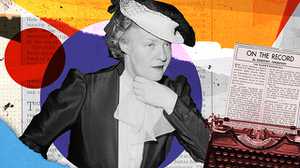Scenes from Nazi Summer Camp
In the years leading up to WWII, children across the United States spent their summers learning archery and antisemitism.

Camp Wille und Macht—Will and Might—came first, in 1934, and was joined in New Jersey by Camp Nordland in Andover and Camp Bergwald in Bloomingdale. In Wisconsin, Camp Hindenberg claimed ground along the banks of the Milwaukee River, and children left their homes for Camp Siegfried in Long Island, the Deutschhorst Country Club in Pennsylvania and Sutter Camp in Los Angeles, California. Photographs and footage from the 1930s document those children pitching tents, cooking baked beans, hiking and singing songs. “It looks like any kind of Boy Scout camp or Girl Scout camp,” author Arnie Bernstein told American Experience. “But these were Nazi camps in America.”
The camps were owned and operated by the German American Bund, a pro-Nazi organization formed by U.S. citizens of German descent in the years leading up to World War II. With scores of chapters and thousands of members across the country, the Bund promulgated an antisemitic, isolationist agenda that sought to establish Nazi ideology in the new homeland. An important part of Bund policy was the creation of a program modeled after the Hitler Youth, the Nazi movement for young Germans. Bund parents enrolled children as young as six into the Jungvolk, which at age 14 split into the Jugendschaft for boys and Mädchenschaft for girls. The Bund camps became the main site for their indoctrination.
Most of the camps were located in New Jersey, New York and Pennsylvania, but others sprouted up in locations like Michigan, Illinois, Wisconsin and California, with an estimated 15 to 25 camps distributed across the country, most in communities with a large German diaspora. Campers were dressed in uniforms featuring the Hitler Youth’s lightning bolt insignia, adorned with swastika pins and given knives inscribed with the phrase “Blut und Ehre,” or “blood and honor.” Daily activities also took on militaristic tones, including target practice and the Sieg Heil salute.
The Bund also published a German-language magazine for its youth members—first called Jung Sturm and then Junges Volk—whose pages featured campers’ accounts and photo spreads dedicated to selective parts of the camp experience. Not depicted, however, were activities that later became public knowledge—like forced nighttime marches that culminated in fireside renditions of the Nazi anthem—after an erstwhile camper testified in 1939 before the House Committee on Un-American Activities. (HUAC was originally formed in part to address concerns about the Bund, as well as other Fascist and Communist organizations in the U.S.) Its leader was ultimately charged with embezzlement, and the group’s assets were seized; some of its leaders and members deported. As the Bund’s troubles multiplied and membership dwindled, the camps closed.
But many of the camps’ archives survived, as did, presumably, children’s recollections of their time spent there and the messages that accompanied it. “It was an experience, a trip, that will remain in our memories forever,” Adirondacks camp director Gregor wrote in Junges Volk.

The German Youth Association will be opening a camp this summer… I’m looking forward to what we’re going to do. We’ll go swimming, play soccer, do gymnastics, go on rides, tell stories, go for walks, do outdoor activities and play lots and lots of games. And now the best part: get up at 6:30 a.m. tomorrow morning and bathe in ice-cold water.” - Edgar, 11, camper in Jungsturm

The bugle wakes you up for morning exercise, washing and raising the flag. After the stars and stripes and the camp flag have been hoisted, the pennants are put in their places, the daily motto is announced and a new camp day begins, filled with work and pleasure until curfew.” - Anita, 14, camper, in Junges Volk



Just watch those long columns march past, their gaily colored flags flying in the breeze, their strong, tanned legs keeping time to the roll of the long drums, and you shall realize the value of the camp: training ground for the generation of tomorrow. This new generation used to the rigors of camp-life with its long marches, its lonely sentinel duty, its life in the open by rain and storm and hot, burning sun, will be fit to carry on the resurrection of the German in America.” - Paul M. Ochojski, Junges Volk columnist

We stayed at this fabulous lake for another week and a half, shot wild game and climbed the highest mountains, before it was time to go home. It was an experience, a trip, that will remain in our memories forever. Our youth group has been going to this wonderful mountain range for four years now to set up a summer camp there.” - Gregor, camper, in Jungsturm

We look with heartfelt reverence and sincere trust to the great leader of our old homeland, with the wish that God bless his new work—we are aware of our responsibility as German-American youth and will do our part to ensure that the new spirit of our times will once again become a force for the renewed health of our people. Rise up!” - Erna, camper, in Jungsturm
This is our main goal, to create a large community of American-German youth, where all boys and girls who are of German blood pass through our youth movement. We want to ensure that the German race of the American people will be healthier and stronger, and from which the leaders of the nation will emerge.” - Junges Volk editorial, summer 1937










